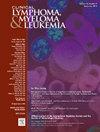加拿大共识指南联盟对新诊断符合移植条件的多发性骨髓瘤的一线治疗建议。
IF 2.7
4区 医学
Q2 HEMATOLOGY
引用次数: 0
摘要
多发性骨髓瘤(MM)有效疗法的出现,引发了对一线自体干细胞移植(ASCT)作用的讨论,尤其是在标准风险患者中。然而,对高危患者的治疗效果仍不理想。随着新型疗法的提早使用,MM领域的治疗方法正在发生迅速变化。目前,四联诱导疗法(包括抗 CD38 单克隆抗体、蛋白酶体抑制剂和免疫调节药物)是符合移植条件的 MM(TEMM)患者获得深度和持续应答的首要策略。加拿大共识指南联盟(CGC)提出了 TEMM 一线治疗的共识建议。为了满足医生和确诊为 MM 患者的需求,本文件重点关注 ASCT 资格、诱导治疗、动员和采集、调理、巩固和维持治疗,以及高危人群、不良反应管理、治疗反应评估和疾病复发监测。CGC 将定期审查本文中的建议,并在必要时进行更新。本文章由计算机程序翻译,如有差异,请以英文原文为准。
First Line Treatment of Newly Diagnosed Transplant Eligible Multiple Myeloma Recommendations From a Canadian Consensus Guideline Consortium
The availability of effective therapies for multiple myeloma (MM) has sparked debate on the role of first line autologous stem cell transplantation (ASCT), particularly in standard-risk patients. However, treatment for individuals with high-risk disease continues to display suboptimal outcomes. With novel therapies used earlier, practice is changing rapidly in the field of MM. Presently, quadruplet induction therapy incorporating an anti-CD38 monoclonal antibody to a proteasome inhibitor and an immunomodulatory drug prior to ASCT followed by maintenance therapy stands as the foremost strategy for attaining deep and sustained responses in transplant eligible MM (TEMM).
This Canadian Consensus Guideline Consortium (CGC) proposes consensus recommendations for the first line treatment of TEMM. To address the needs of physicians and people diagnosed with MM, this document focuses on ASCT eligibility, induction therapy, mobilization and collection, conditioning, consolidation, and maintenance therapy, as well as, high-risk populations, management of adverse events, assessment of treatment response, and monitoring for disease relapse. The CGC will periodically review the recommendations herein and update as necessary.
求助全文
通过发布文献求助,成功后即可免费获取论文全文。
去求助
来源期刊

Clinical Lymphoma, Myeloma & Leukemia
ONCOLOGY-HEMATOLOGY
CiteScore
2.70
自引率
3.70%
发文量
1606
审稿时长
26 days
期刊介绍:
Clinical Lymphoma, Myeloma & Leukemia is a peer-reviewed monthly journal that publishes original articles describing various aspects of clinical and translational research of lymphoma, myeloma and leukemia. Clinical Lymphoma, Myeloma & Leukemia is devoted to articles on detection, diagnosis, prevention, and treatment of lymphoma, myeloma, leukemia and related disorders including macroglobulinemia, amyloidosis, and plasma-cell dyscrasias. The main emphasis is on recent scientific developments in all areas related to lymphoma, myeloma and leukemia. Specific areas of interest include clinical research and mechanistic approaches; drug sensitivity and resistance; gene and antisense therapy; pathology, markers, and prognostic indicators; chemoprevention strategies; multimodality therapy; and integration of various approaches.
 求助内容:
求助内容: 应助结果提醒方式:
应助结果提醒方式:


